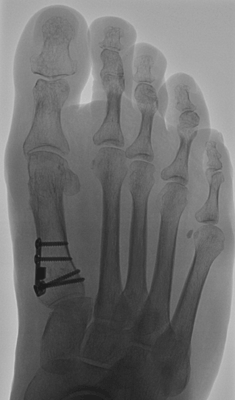Opening wedge osteotomy performed with plate fixation maintains metatarsal length
All but three of the patients showed clinical and radiographic healing at 6 weeks postoperative.
VANCOUVER, British Columbia — Using a specialized plate to stabilize an opening wedge first metatarsal osteotomy for the treatment of patients with hallux valgus shows good healing and correction while avoiding metatarsal shortening, according to investigators.
“This seems to be a reliable operation,” William M. Granberry, MD, said during his presentation at the 25th Annual Summer Meeting of the American Orthopaedic Foot and Ankle Society. “Metatarsal length is maintained. There are some minimal technical difficulties. Especially, I would recommend this if there is any pre-existing transfer metatarsalgia.”
Technique
Granberry performed a proximally based opening wedge osteotomy using a low-profile plate with wedges of varying lengths on 36 feet in 28 patients. The patients averaged 55 years of age and most were women. The study also included three revision cases. Overall, the patients had an average preoperative hallux valgus angle of 34° and an intermetarasal angle of 17°.
|
|
Images: Granberry WM |
During the procedure, Granberry performed an incomplete osteotomy at 1 cm distal to the tarsometatarsal joint. He then applied the plate and inserted autologous bone graft into the defect. All of the patients also underwent a bunionectomy procedure except for the three revision cases. The patients had a minimum follow-up of 6 months and underwent their first radiographic evaluation at 6 weeks.
Healing
|
|
“All but three of these osteotomies healed at the first X-ray,” Granberry said. “There were two delayed unions and one nonunion.” He noted that the delayed unions were probably related to placing the osteotomy too close to the tarsometatarsal joint. One patient with delayed union received an allograft and the other underwent hardware removal. Both patients eventually healed at 10 weeks. The one nonunion case was revised using a locking plate.
Overall, the investigators discovered that the patients had an average correction of 9.4° in the intermetatarsal angle after bunion correction and an average correction of 17.6° in the hallux valgus angle. They also found that the average intermetatarsal angular correction was 2.2° per millimeter of the opening wedge plate thickness and that the forefoot width decreased an average of 7 mm.
The metatarsal length increased an average of 0.6%.
“The couple that shortened were those with nonunion or delayed unions,” Granberry said.
The session moderator, Judith F. Baumhauer, MD, MPH, asked Granberry how patients’ preoperative range of motion impacts his decision to perform an opening wedge osteotomy.
“The problem is that there is an expected postoperative amount of stiffness but, as far as preoperatively, I do not have data for that other than it should be tested preoperatively,” Granberry said. “I think the more important question is whether there is going to be a transfer metatarsalgia.” He said that a long metatarsal can contribute to the condition. – by Gina Brockenbrough
Reference:
- Granberry WM, Merriman D. A radiographic analysis of an opening wedge first metatarsal osteotomy for treatment of hallux valgus. Presented at the 25th Annual Summer Meeting of the American Orthopaedic Foot and Ankle Society. July 15-18, 2009. Vancouver, British Columbia.
- Judith F. Baumhauer, MD, MPH, can be reached at University of Rochester School of Medicine, 601 Elmwood Avenue, Box 665, Rochester, NY 14642; 585-275-5321; e-mail: Judy_Baumhauer@urmc.rochester.edu.
- William M. Granberry, MD, can be reached at Bone & Joint Clinic of Houston, 6624 Fannin Street, Suite 2600, Houston, TX 77030; 713-790-1818; e-mail: wmgran@bjc-houston.com.



